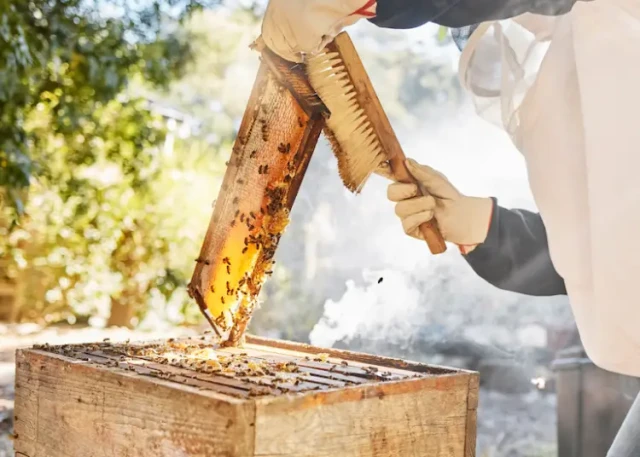Beekeeping requires precision tools that balance efficiency with bee welfare. A bee brush, when used correctly, becomes one such indispensable tool—allowing beekeepers to inspect hives or harvest honey without stressing the colony. This guide covers optimal techniques, material choices, and common pitfalls to avoid, ensuring both bee health and beekeeper productivity.
Why Soft Bristles Matter for Bee Safety
The right bristle type prevents injury to bees. Research shows that stiff or synthetic bristles can damage bees’ delicate wings and remove protective hairs from their bodies. Soft-bristled brushes (typically made from horsehair or plant fibers) provide enough flexibility to gently guide bees away without harm.
Key considerations when selecting a brush:
- Material: Natural fibers are less abrasive than nylon.
- Bristle density: Sparse bristles reduce friction, while densely packed ones may trap bees.
- Handle length: Longer handles (10–12 inches) keep your hands farther from agitated bees.
Pro Tip: Dampening the bristles slightly with water can help minimize static, which tends to agitate bees further.
Step-by-Step Techniques for Stress-Free Bee Removal
1. Work During Optimal Hours
Bees are calmer in late morning or early afternoon when foraging activity peaks. Avoid brushing during cold or rainy weather when bees cluster defensively.
2. Angle the Brush Correctly
- For frames: Brush downward in the bees’ natural movement direction (toward the hive entrance).
- For hive boxes: Use slow, sweeping motions parallel to the comb surface.
3. Limit Brush Strokes
Excessive brushing disorients bees. Aim to clear 80–90% of bees in 2–3 strokes; smoke the remaining few if necessary.
4. Post-Brushing Care
Return cleared frames quickly to reduce bee agitation. Observe the colony afterward for signs of stress (e.g., prolonged buzzing or clustering outside the hive).
Alternatives to Bee Brushes: When to Use What
While bee brushes excel for precise work, other tools better suit specific scenarios:
| Tool | Best For | Bee-Friendliness |
|---|---|---|
| Bee Blower | Large-scale honey extraction | Moderate (loud noise may stress bees) |
| Fume Board | Clearing supers pre-harvest | High (uses natural repellents like almond oil) |
| Leaf Blower | Emergency swarm removal | Low (risk of wing damage) |
Note: For routine inspections, a brush remains the safest option.
Common Mistakes and How to Avoid Them
1. Over-Brushing
Problem: Repeated brushing dehydrates bees by removing their protective wax coating.
Fix: Combine brushing with light smoking to encourage natural movement.
2. Using Dirty Brushes
Problem: Residue from propolis or honey makes bristles sticky, increasing bee mortality.
Fix: Clean brushes weekly with warm water and let them air-dry.
3. Brushing Queen Bees
Problem: Accidentally harming the queen disrupts colony stability.
Fix: Mark the queen with a dot of non-toxic paint for easy identification.
Ready to Upgrade Your Beekeeping Toolkit?
HONESTBEE’s wholesale-focused supplies—including ergonomic bee brushes and natural fiber replacements—help commercial apiaries and distributors prioritize bee health while streamlining operations. [Explore our beekeeping solutions] to equip your business with tools that balance efficiency and ethical hive management.
Final Thought: A well-used bee brush exemplifies how small tools can uphold the delicate harmony between human productivity and insect welfare—proving that careful technique shapes sustainable beekeeping.
関連製品
- プラスチックハンドルの単一の列の人工的な繊維の蜂ブラシ
- クラシック木製ハチブラシ、猪毛二重列
- スライド式ゲートとフィーダープラグ付きプロフェッショナル女王蜂ケージ
- 養蜂用二重列人工繊維ハチブラシ
- プロ用ステンレス鋼Jフック式ハイブツール




















